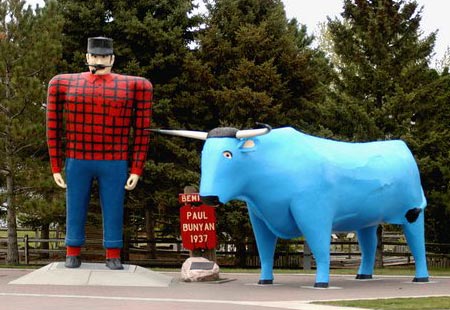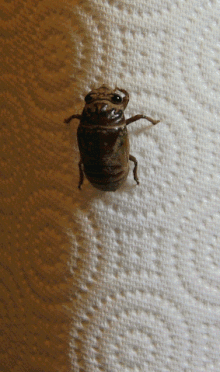I have a plan though. One of our 3 chicken tractors on the pasture is smaller than the others. I use it primarily for placing pullets in while they are growing and before I let them roam free on the pasture. While they are small and susceptible to hawk or owl predation, I keep them in the tractor where they will be safe. The only problem with that is, Big Boy. Big Boy, aka Bad Boy, is our Great Pyrenees livestock guard dog. When the last chickens moved out to free range, he began occupying the chicken tractor as a respite from the heat of the summer. It was his dog house and he wasn't a good house keeper. He pulled all the chicken wire off of it and dug holes to cool himself in the cool dirt.
 |
| Item #1: Need to put wire back on chicken tractor |
 |
| Item #2: Need to fill in Big Boy's craters |
I moved Big Boy out of the chicken tractor to his new area. He's done a great job in protecting our livestock. We haven't lost a single bird to predators. But as with most of us, he's got some character flaws that we're trying to work on.
 |
| Big Boy's new area |
One of the things I tried on the chicken tractor last year that didn't work was having casters on the front. Casters did allow me to turn the chicken tractor SO much easier, but not after a rain. They would dig down in the mud and I'd have to lay boards down in order to roll the tractor forward. I like to roll the tractor to fresh grass each and every day, so that the birds can forage for fresh grass, seeds, and bugs.
 |
| Mud clogged casters |
I anticipated this problem and got double-wheeled casters, but they still didn't work, so off they come.
 |
| The caster was a disaster |
I used a drill to put a hole in the frame and then placed two wheels on each side to replace the casters. These wheels will roll better, but when you want to turn the tractor, you must lift it.
 |
| Item #3: Replacing the casters with wheels. |
Here's what the finished product looks like:
 |
| New wheels for the tractor |
I had saved the 2 x 4 welded wire fencing that I removed from the garden and I measured the amount I'd need and cut exactly that amount. Benjamin helped me staple it to the frame. I have half of the tractor enclosed with corrugated tin and half enclosed with fencing. This allows the birds to have shelter from the wind and rain, but still have the fresh air, sun and breeze as well - the best of both worlds.
 |
| My trusty helper |
Then I put the Momma Hen and her three little biddies in the tractor. Look how big they are getting! Just the other day they were little cute chicks. In no time they've grown up and aren't so cute anymore. Well, no more getting in the garden - Or so I thought! Those little boogers squeezed themselves between the gaps in the 2 x 4 fencing and lo and behold, the next morning they were scratching in the garden.
 |
| Momma and Biddies in the chicken tractor |
To fix this, I measured again and cut another piece of fencing and offset it against the fencing Benjamin stapled to the chicken tractor. I used tie wire and staples to affix the second piece of fencing to the frame. If you look in the far corner, you can see the biddies behind the trough and waterer. It worked!
 |
| Now you're not getting out! |
However, the very next morning, I was greeted to this sight. You know what it is? Some creatures poked their head through the 2 x 4 welded wire fencing and broke the welds. The creatures then craned their necks through, widening the hole until they were able to eat the rice that I had poured into the trough for the momma hen and her chicks.
 |
| Doggonit!!!! |
Wanna guess who the perpetrators were? Here's their mugshots right here:
 |
| Guilty as Charged |
In the Gospel of Matthew, Chapter 25:31-46, our LORD tells the parable of the sheep and the goats:
The Judgment
31 “But when the Son of Man comes in His glory, and all the angels with Him, then He will sit on His glorious throne. 32 All the nations will be gathered before Him; and He will separate them from one another, as the shepherd separates the sheep from the goats;33 and He will put the sheep on His right, and the goats on the left.
34 “Then the King will say to those on His right, ‘Come, you who are blessed of My Father,inherit the kingdom prepared for you from the foundation of the world. 35 For I was hungry, and you gave Me something to eat; I was thirsty, and you gave Me something to drink; I was a stranger, and you invited Me in; 36 naked, and you clothed Me; I was sick, and you visited Me; I was in prison, and you came to Me.’ 37 Then the righteous will answer Him, ‘Lord, when did we see You hungry, and feed You, or thirsty, and give You something to drink? 38 And when did we see You a stranger, and invite You in, or naked, and clothe You? 39 When did we see You sick, or in prison, and come to You?’ 40 The King will answer and say to them, ‘Truly I say to you, to the extent that you did it to one of these brothers of Mine, even the least of them, you did it to Me.’
41 “Then He will also say to those on His left (the goats), ‘Depart from Me, accursed ones, into the eternal fire which has been prepared for the devil and his angels; 42 for I was hungry, and you gave Me nothing to eat; I was thirsty, and you gave Me nothing to drink; 43 I was a stranger, and you did not invite Me in; naked, and you did not clothe Me; sick, and in prison, and you did not visit Me.’ 44 Then they themselves also will answer, ‘Lord, when did we see You hungry, or thirsty, or a stranger, or naked, or sick, or in prison, and did not take care of You?’ 45 Then He will answer them, ‘Truly I say to you, to the extent that you did not do it to one of the least of these, you did not do it to Me.’ 46 These will go away into eternal punishment, but the righteous into eternal life.”
Before we owned goats, I used to wonder when reading this passage why the goats were seen as the evil ones, the bad characters. Now, I know why. Yes, indeed. Now I know why...









































